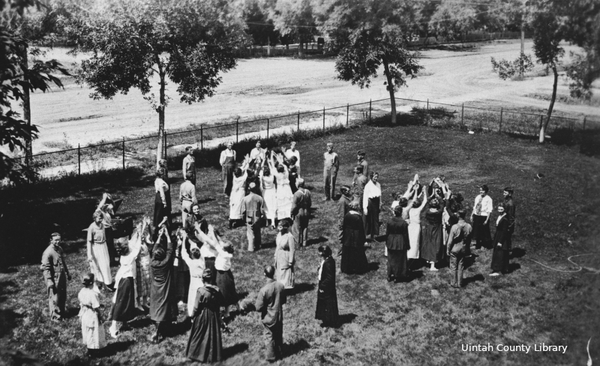Dublin Core
Title
Dancing for Good: Community Aid in Rural Utah
Description
In rural Utah, social dances were important events that brought townsfolk together, not only for fun, but to support each other and their community.
Life in rural Utah in the late nineteenth century was tough! Utahns worked hard to support their families and regularly struggled with drought, floods, illness, and more. Despite the daily hardships, however, community members still found time to enjoy each other’s company. Activities generally centered around family-friendly pastimes such as community dances, which were popular throughout the state. Entire families attended. Mothers placed sleeping babies in bedrooms or created makeshift sleeping areas on benches or floorboards. Small children listened to music, learned social etiquette and practiced dance steps. Young adults could meet and dance the night away in an informal setting.
But beyond having a good time, dances helped ease the challenges of rural life by providing a space for social engagement and community service in rural Utah. For example, buying tickets to town dances didn’t always require cash. Some charged admission in the form of wood, meat, or crops. These entrance fees provided food or fuel to the local church and needy members of the town.
In Escalante, dancers paid for their admission with grains and produce. In Hebron, men raced to cut and haul firewood for a woodcutting contest. Their hard work provided firewood to benefit the local church and the losing team hosted a dance and picnic. The benefits were twofold: the church would have enough firewood for the winter and the town got to enjoy food and dance when the work was done.
In Beaver, “wood dances” celebrated an abundant harvest and the end of a season of hard work. In exchange for dance tickets, men and boys would cut and haul firewood for the local church and school. Women prepared a celebratory dinner of meats, pies, cakes, and jellies. Additionally, they would portion out enough to help widows or needy families in the community. After the hearty dinner, attendees would dance and socialize until late into the night.
Dances occurred regularly and were usually held in homes or churches on Friday evenings or on holidays. Essential to community life, these events eased loneliness and offered Utahns a chance to relax, socialize, and serve their neighbors.
Life in rural Utah in the late nineteenth century was tough! Utahns worked hard to support their families and regularly struggled with drought, floods, illness, and more. Despite the daily hardships, however, community members still found time to enjoy each other’s company. Activities generally centered around family-friendly pastimes such as community dances, which were popular throughout the state. Entire families attended. Mothers placed sleeping babies in bedrooms or created makeshift sleeping areas on benches or floorboards. Small children listened to music, learned social etiquette and practiced dance steps. Young adults could meet and dance the night away in an informal setting.
But beyond having a good time, dances helped ease the challenges of rural life by providing a space for social engagement and community service in rural Utah. For example, buying tickets to town dances didn’t always require cash. Some charged admission in the form of wood, meat, or crops. These entrance fees provided food or fuel to the local church and needy members of the town.
In Escalante, dancers paid for their admission with grains and produce. In Hebron, men raced to cut and haul firewood for a woodcutting contest. Their hard work provided firewood to benefit the local church and the losing team hosted a dance and picnic. The benefits were twofold: the church would have enough firewood for the winter and the town got to enjoy food and dance when the work was done.
In Beaver, “wood dances” celebrated an abundant harvest and the end of a season of hard work. In exchange for dance tickets, men and boys would cut and haul firewood for the local church and school. Women prepared a celebratory dinner of meats, pies, cakes, and jellies. Additionally, they would portion out enough to help widows or needy families in the community. After the hearty dinner, attendees would dance and socialize until late into the night.
Dances occurred regularly and were usually held in homes or churches on Friday evenings or on holidays. Essential to community life, these events eased loneliness and offered Utahns a chance to relax, socialize, and serve their neighbors.
Creator
By Mikee Ferran for Utah Humanities © 2023
Source
Image: Square dancers on the Central School lawn, Vernal, Utah, c 1900. Dancing brought members of Utah’s rural towns together. Ticket prices often benefited community members or spaces. Image courtesy of Uintah County Library Regional History Center.
________________
See “Wood Dances Became Annual Events in Some Rural Towns,” The History Blazer, May 1995; Miriam B. Murphy, A History of Wayne County, Utah State Historical Society, 1999; Larry V. Shumway, “Dancing the Buckles off their Shoes in Pioneer Utah,” BYU Studies Quarterly 37 (3), 1997-98; Daughters of Utah Pioneers, Monuments to Courage: A History of Beaver County, 1948; Jenny Lind M. Brown, “Dancing in Early Gunnison Valley,” Saga of the Sanpitch vol. 18, 1986.
________________
See “Wood Dances Became Annual Events in Some Rural Towns,” The History Blazer, May 1995; Miriam B. Murphy, A History of Wayne County, Utah State Historical Society, 1999; Larry V. Shumway, “Dancing the Buckles off their Shoes in Pioneer Utah,” BYU Studies Quarterly 37 (3), 1997-98; Daughters of Utah Pioneers, Monuments to Courage: A History of Beaver County, 1948; Jenny Lind M. Brown, “Dancing in Early Gunnison Valley,” Saga of the Sanpitch vol. 18, 1986.
Publisher
The Beehive Archive is a production of Utah Humanities. Find sources and the whole collection of past episodes at www.utahhumanities.org/stories.
Date
2023-11-2 7

